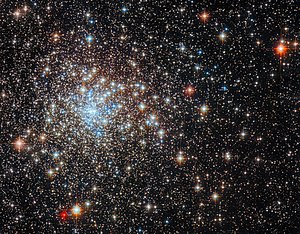NGC 6325
| Kugelsternhaufen NGC 6325 | |
|---|---|
(c) ESA/Hubble, CC BY 4.0 | |
| Aufnahme eines weiten Bereichs des Kugelsternhaufens NGC 6325 mithilfe des Hubble-Weltraumteleskops | |
| AladinLite | |
| Sternbild | Schlangenträger |
| Position Äquinoktium: J2000.0, Epoche: J2000.0 | |
| Rektaszension | 17h 17m 59,3s [1] |
| Deklination | −23° 45′ 58″ [1] |
| Erscheinungsbild | |
| Konzentrationsklasse | IV [2] |
| Helligkeit (visuell) | 10,2 mag [2] |
| Helligkeit (B-Band) | 11,49 mag |
| Winkelausdehnung | 4,1' [2] |
| Physikalische Daten | |
| Entfernung | 25,4 kLj |
| Geschichte | |
| Entdeckung | John Herschel |
| Entdeckungsdatum | 24. Mai 1835 |
| Katalogbezeichnungen | |
| NGC 6325 • C 1714-237 • GCl 58 • ESO 519-SC11 • GC 4283 • h 3676 | |
NGC 6325 ist ein Kugelsternhaufen im Sternbild Schlangenträger.
Der Sternhaufen wurde im Jahr 1835 von John Herschel mithilfe eines 18,7 Zoll-Teleskops entdeckt und später von Johan Dreyer in seinen New General Catalogue aufgenommen.[3]
Weblinks
Einzelnachweise
Auf dieser Seite verwendete Medien
(c) ESA/Hubble, CC BY 4.0
The densely packed globular cluster NGC 6325 glistens in this image from the NASA/ESA Hubble Space Telescope. This concentrated group of stars lies around 26 000 light years from Earth in the constellation Ophiuchus.Globular clusters like NGC 6325 are tightly bound collections of stars with anywhere from tens of thousands to millions of members. They can be found in all types of galaxies, and act as natural laboratories for astronomers studying star formation. This is because the constituent stars of globular clusters tend to form at roughly the same time and with similar initial composition, meaning that astronomers can use them to fine-tune their theories of how stars evolve. Astronomers inspected this particular cluster not to understand star formation, but to search for a hidden monster. Though it might look peaceful, astronomers suspect this cluster could contain an intermediate-mass black hole that is subtly affecting the motion of surrounding stars. Previous research found that the distribution of stars in some highly concentrated globular clusters — those with stars packed relatively tightly together — was slightly different from what astronomers expected.This discrepancy suggested that at least some of these densely packed globular clusters — including perhaps NGC 6325 — could have a black hole lurking at the centre. To explore this hypothesis further, astronomers turned to Hubble’s Wide Field Camera 3 to observe a larger sample of densely populated globular clusters, which included this star-studded image of NGC 6325. Additional data from Hubble’s Advanced Camera for Surveys were also incorporated into this image.[Image Description: A dense cluster of bright stars. The core of the cluster is to the left and has a distinct group of blue stars. Surrounding the core are a multitude of stars in warmer colours. These stars are very numerous near the core and become more and more sparse, and more small and distant, out to the sides of the image. A few larger stars also stand in the foreground near the edges of the image.]

